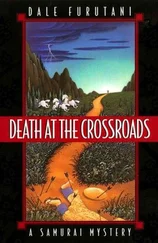Dale Furutani - The Toyotomi Blades
Здесь есть возможность читать онлайн «Dale Furutani - The Toyotomi Blades» весь текст электронной книги совершенно бесплатно (целиком полную версию без сокращений). В некоторых случаях можно слушать аудио, скачать через торрент в формате fb2 и присутствует краткое содержание. Год выпуска: 2012, Жанр: Криминальный детектив, на английском языке. Описание произведения, (предисловие) а так же отзывы посетителей доступны на портале библиотеки ЛибКат.
- Название:The Toyotomi Blades
- Автор:
- Жанр:
- Год:2012
- ISBN:нет данных
- Рейтинг книги:4 / 5. Голосов: 1
-
Избранное:Добавить в избранное
- Отзывы:
-
Ваша оценка:
- 80
- 1
- 2
- 3
- 4
- 5
The Toyotomi Blades: краткое содержание, описание и аннотация
Предлагаем к чтению аннотацию, описание, краткое содержание или предисловие (зависит от того, что написал сам автор книги «The Toyotomi Blades»). Если вы не нашли необходимую информацию о книге — напишите в комментариях, мы постараемся отыскать её.
The Toyotomi Blades — читать онлайн бесплатно полную книгу (весь текст) целиком
Ниже представлен текст книги, разбитый по страницам. Система сохранения места последней прочитанной страницы, позволяет с удобством читать онлайн бесплатно книгу «The Toyotomi Blades», без необходимости каждый раз заново искать на чём Вы остановились. Поставьте закладку, и сможете в любой момент перейти на страницу, на которой закончили чтение.
Интервал:
Закладка:
4
How can you return to a place you’ve never been? That’s something I puzzled over as I pressed my face against the hazy Plexiglas of the plane window. Through my cheek I could feel the cold of forty-eight thousand feet.
I was flying in the upper cabin of a 747 and loving it. I’ve flown on Boeing 747s before, but I didn’t realize that some of them have an upper deck with about twenty business class seats. On domestic flights, I’ve always flown in what airlines call economy class, but which I call steerage. On a 747, steerage means a lot of people jammed into a confined space. In the upper deck the seats were only two abreast and there were two flight attendants to take care of our needs. When I boarded the plane and climbed the spiral staircase that went to the upper deck, I noticed the plush leather-covered seats for first class in the front of the plane, but I wasn’t envious. On my only other international flight, I was jammed in a MATS plane with more than one hundred other teenagers going to war in Vietnam, all of us trying not to show how scared we were. Business class to Japan was my best flying experience. If that makes me a bumpkin, then I plead guilty.
Below, on the horizon, came the coast of Japan. All I could see was a thin, gray line that might or might not turn into something more interesting as the plane rushed forward. I was disappointed that the coastline didn’t provide a more spectacular view. Although I’ve never been to Japan, I felt that in some way this was a homecoming. I’ve always considered Hawaii home, even though I’ve now lived in Los Angeles for most of my life. My family’s been in Hawaii since 1896, but my grandfather and grandmother came from Japan. So, although Hawaii is home, Japan is the homeland.
I’m a Sansei, or third generation Japanese-American. Like most third generation Americans, I’ve forgotten a lot of my roots, but I’m still aware of all sorts of influences on my outlook and actions that are caused by the fact that my grandparents were Japanese. Certainly the way I fit into American society has been affected because of that heritage.
The airplane’s public address system came to life and something was said in Japanese. I was flying All Nippon Airlines, ANA, and it made me vaguely uncomfortable that all announcements were first made in Japanese and then English. In case of an emergency, I didn’t want every Japanese-speaking passenger up and rushing for an exit while I was still waiting for a translation.
“Ladies and gentlemen,” the voice on the PA finally began in English, “we will be landing at Narita in approximately fifty minutes, so if you have not already done so, please fill out your disembarkation pass for submission to Japanese customs.”
I checked the small white card that all visitors have to fill out and put it back in my pocket. I took a few deep breaths. At Los Angeles International Airport, I had been surprisingly nervous, and sensing my mood, Mariko had given me an especially loving send-off. I don’t know what I was nervous about, but I think it was a combination of going to Japan for the first time and the prospect of being on television. Like any Angeleno, I’m pretty blase about the entertainment business because there’s so much of it in the city. But this would be my first time on television, and to complicate things, it would be a live show and in Japanese.
To pass the time, I took a copy of Things Very, Very Japanese by Bob Thomas from my travel bag. I sought the card I had stuck in as a bookmark and started reading a piece on tsuba, Japanese decorative sword guards. I bought three guidebooks for my trip to Japan. Books on Japan are like books about sex or music-they explain things in academic terms, but they can’t convey the feelings or emotions involved in the actual experience.
I know a lot of individual Japanese words and phrases, and in college I studied Japanese history. Despite that, I never visited the object of my interest. In Yasunari Kawabata’s novel Snow Country there’s a character who’s an expert on Western ballet. In spite of having an encyclopedic knowledge on the subject, he has never actually seen a ballet. In some ways, I emulate this character.
A few minutes later, I looked out the window again and the gray line on the horizon had turned into a rocky coastline. The plane was too high to make out details, but I could see how rugged and mountainous the land was. As the plane came lower in its approach to Tokyo International Airport at Narita, I saw fall colors breaking through the haze. Red, yellow, and a pale orange splashed the trees that were clustered on the mountainsides. Spoiling the beauty, I also saw that great gouges had been taken out of some of the hills, exposing raw, red earth. The mountains were also crisscrossed with ugly electrical lines and high-tension towers. The woods, towers, and gouges formed a crazy quilt that didn’t match my notions of how ordered Japan would be.
Once I arrived at the airport, my idea of Japanese efficiency was reaffirmed. The airport was crowded, but clean and well run to the point of coldness. At the immigration desk, the clerk looked at my American passport and silently looked up to confirm that the owner matched the picture.
I took one of the metal carts provided and gathered up my luggage as it appeared on the endless belt. I then joined the mass of Japanese and tourists lining up for customs inspection. I moved the cart to one of the customs stations with the green nonresident sign. When it was my turn to have my baggage inspected, the Japanese customs agent in the gray-blue uniform glared at me. In L.A. gang terms, he gave me a hard look. In Hawaii, we’d call it the stink eye. Whatever you call it, it was plain he wasn’t happy. He said something in Japanese. I gave the agent a puzzled look. The agent repeated himself, this time much more harshly.
“Excuse me, but do you speak English? I’m afraid I don’t speak Japanese,” I said.
The agent looked at me in surprise. “Are you an American?” he asked in very good English.
It never occurred to me that I would be taken for a Japanese national, although obviously, with two Japanese-American parents, I look Japanese. “Yes, I am,” I said.
His whole demeanor changed. A smile spread across his face and he pulled my bags through the customs table without checking a single one. “Welcome to Japan,” the agent said cheerily.
I walked out of the baggage area into a milling mass of people. Most appeared to be families looking for loved ones, but a great number were limousine drivers or businessmen holding signs with names in English or Japanese. When I’d called Sugimoto to set up the trip, he’d said he’d meet me at the airport, so I scanned the businessmen to see if I could spot one holding a sign with my name on it. As I was searching for Sugimoto, a man came up to me. He was dressed in a plain white T-shirt, Levi’s jeans, black motorcycle boots, and a black leather belt with a large, silver Harley-Davidson belt buckle. His hair looked permed into curls and he wore it with an authentic 1950s jelly-roll lock of hair cascading down his forehead.
In the Thomas book about Japan I had read about the youngsters who gather at Yoyogi Park every Sunday all decked out in 1950s American regalia, complete with black leather jackets and poodle skirts. The young people go there to dance, play music, and meet other kids. Those kids were teenagers, but this man was at least in his midthirties, and he seemed long-of-tooth for dressing up like James Dean. To my surprise, he stuck out his hand and said, “Mr. Tanaka, I’m Buzz Sugimoto.”
He must have been used to people doing double takes, because he showed no reaction when I did mine. This kind of appearance could be expected in Los Angeles, but here in Tokyo it was totally incongruous to me. I had enough wit to shake his hand.
Читать дальшеИнтервал:
Закладка:
Похожие книги на «The Toyotomi Blades»
Представляем Вашему вниманию похожие книги на «The Toyotomi Blades» списком для выбора. Мы отобрали схожую по названию и смыслу литературу в надежде предоставить читателям больше вариантов отыскать новые, интересные, ещё непрочитанные произведения.
Обсуждение, отзывы о книге «The Toyotomi Blades» и просто собственные мнения читателей. Оставьте ваши комментарии, напишите, что Вы думаете о произведении, его смысле или главных героях. Укажите что конкретно понравилось, а что нет, и почему Вы так считаете.












